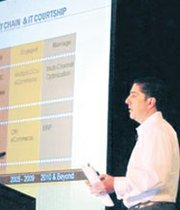Technology in Application: Lessons Learned Along the Supply Chain
NEW YORK—The phrase “slow and lumpy” may be anathema in the bridal business, and yet, the supply-chain executives at David’s Bridal are perpetually challenged with squeezing efficiency out of a “slow and lumpy demand stream.”
David’s Bridal stores sell gowns and dresses for brides, bridesmaids, mothers of the bride, flower girls and prom, as well as accessories such as veils, shoes, lingerie and purses. In recent years, the 61-year-old chain has branched into related services, including photography. David’s Bridal customers can buy off-the-rack or place an order with a set delivery date.
In addition to the bridal gown, there are a myriad of choices for accessories and a seemingly limitless number of options for bridesmaids dresses. And each decision comes with a delivery date—sometimes multiple dates to account for alterations, “pre-pictures” and far-flung bridesmaids. And everything has to be perfect.
“It’s a highly emotional purchase,” said Mike Toth, vice president of business systems and IT QA for David’s Bridal. “You do not want to be the one who messed up the bride’s special day.”
Beginning in 2000, the more than 300-store bridal retail chain, based in Conshohocken, Penn., began upgrading and streamlining its supply chain and systems. The company hired a vice president of sourcing and introduced engineering standards—and ensured they’d be followed by instituting an employee incentive program. The company added a vice president of supply chain and set up management teams to oversee work flow and SOCS, the company’s acronym for special orders and customer service.
“Reporting became king,” Toth said. “If you can’t measure it, you don’t know what’s going on.”
The company hired a third party to do a complete network analysis and opened a second distribution center for flat-pack garments. The company now runs two distribution centers—a 174,000-square-foot facility that supports an Equinox hang sorter system and a 192,000-square-foot facility with a Eurosort Bombay sorter. The company added a Veit steam system and an automated bagging system.
Toth and his David’s Bridal colleagues Diane Garforth, director of distribution-center systems, and Tony Coccerino, vice president of logistics/distribution, were among the speakers at the recent Apparel Business & Technology Leadership Conference, held Nov. 3–4 at the Roosevelt Hotel in New York.
Jason Epstein, former chief operating officer of New York–based Haute Hippie, shared Haute Hippie’s search and implementation of a global ERP (enterprise resource management) system to keep up with the nearly 4-year-old contemporary brand’s rapidly growing business.
When Epstein joined the company eight months after Haute Hippie shipped its first collection, “everything was manual; nothing was automated,” he said, and retailers were demanding EDI (electronic data interchange).
Haute Hippie had an ERP system, but it was unable to handle multiple warehouses, Epstein said.
“I didn’t want to invest a year of developing the business on the current ERP system when I knew it had a finite life,” he said.
Haute Hippie needed a new system—and it needed it quickly, Epstein said.
Fortunately, Epstein had served as chief information officer of Elie Tahari and was familiar with several ERP suppliers and systems.
“I knew I had to abandon all traditional implementation methods,” he said. “We had to approach it totally differently.”
Ultimately, Haute Hippie selected Simparel’s ERP system and implemented it in six weeks. The company was able to handle three times the revenue without increasing payroll. Plus, once the users began working on the system, Epstein said, he found it was easy to “layer on additional functionality.”
“It was a cool added benefit I didn’t expect,” he said. “In hindsight, we did it in six weeks, but we probably could have done it faster.”
After implementing the Simparel ERP system, Epstein went to work for the company, where he is now COO.
Amy Villeneuve, president and chief operating officer for Kiva Systems, explained how Iowa-based department-store chain Von Maur expanded its e-commerce operations using Kiva’s mobile robots to streamline fulfillment operations in the warehouse.
And David Bruno, director of commerce studies for San Diego–based RedPrairie Corp., gave a rousing—and well-received—presentation on using social networking to build brands and capture the SoLoMo—or social, local and mobile—consumer.
“Smart devices are everywhere,” Bruno said, adding that there will be 50 billion Internet-connected devices on the planet by 2020. According to Shopatron, people are 50 percent more likely to make a purchase on an iPad than on a desktop browser.
“The lesson is more and more dollars are being spent online,” Bruno said, adding that this holiday season is on track to see an increase in retail sales but a decrease in foot traffic in the store.
The event also included highlights from a recent research survey on sourcing integration and PLM (product lifecycle management) conducted by Gartner and Apparel magazine.
John B.R. Long, partner and head of global marketing for Kurt Salmon, also detailed his company’s “2012 Apparel & Retail Technology Outlook.”
In addition to the seminar series, attendees had a chance to meet with representatives from several companies, including Simparel, Kiva Systems, RedPrairie,Alvanon, Coats VIT, Gerber Technology, Lawson, Hybris, Lectra, NGC, OptiTex, Motorola Solutions Inc., Orion and [TC]2.
Lenny Weiss, North America PLM sales manager for Gerber Technology, said his company had just hosted the 13th annual Ideation, the company’s software users conference in Miami Beach, Fla. The two-day event featured hands-on demonstrations, case studies and expert panels and drew about 300 people, according to Weiss.
“It’s encouraging to go to a user conference and see so many people,” he said.
“In the last two years, we’ve added 37 new PLM systems—some with billion-dollar companies. People need solutions, they need to reduce the time it takes to do things—and they need to do it right.”
























